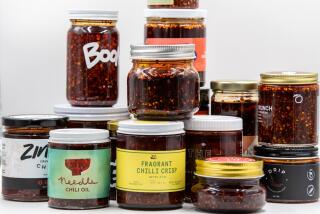Has Connie Chung Distanced Herself From Asian Heritage?
- Share via
Asiam magazine has declared war--of sorts--on NBC newscaster Connie Chung.
In its December issue, due out next week, the Los Angeles-based monthly will feature a profile of Chung that lambastes the broadcaster over “how much she dissociates herself from her Asian heritage,” publisher and editor Tom Kagy said.
After trying to get time with Chung for about two years, Kagy said Wednesday that the magazine obtained an interview last August without telling her who the interview was for until the session was over. He added that Chung then refused to pose for photos and the magazine bought pictures of her from a photographer who had photographed Chung for another publication.
In the generally favorable article, titled “Ms Perfect,” writer Isobel Silden quotes Chung as saying, “Now of course, when I give speeches, I ask the audience: Do you know how hard it is to find your relatives in a country of a billion people who all look alike?”
Silden then concludes, “That last quip points out the discomfort Chung seems to feel at identifying herself with her Asian side. Apparently, her Asianness is something to be joked away.” The article ends, “Chung’s apparent discomfort with her Asian identity is certainly incongruous with her success, reported warmth and apparent strength of character. One can only wonder at the reason.”
Contacted in New York Wednesday, Chung said that she never had a formal interview with Silden and encountered the writer only briefly at an NBC-sponsored press gathering in Los Angeles. The newscaster said that Silden apparently got some of her material from a group interview she gave at the NBC event. Chung also said the allegation that she refused further cooperation because of the magazine’s ethnic ties was “crazy.” And she noted that she has given interviews with other Asian-ethnic publications in the past.
Asiam’s December issue marks the re-emergence of the magazine after a hiatus for a redesign, publisher Kagy said of the 2-year-old, 46,000-circulation monthly.
Asiam, which used to bill itself as “The Asian American Magazine,” now has adopted a new subtitle, “All that Matters in the Pacific Rim,” to signal its expanding horizons, Kagy said.
Meanwhile, another Los Angeles-based Asian-American magazine has been sending out mixed signals about its future.
Late last week the monthly Rice announced it was skipping the planned January issue. Then on Tuesday the magazine partially reversed itself by saying it was combining the January issue with December, according to Will Chow, Rice’s national ethnic advertising director. Last year the magazine also combined its January and December issues, said Chow, the only Rice executive who could be reached for comment.
What this hasty and contradictory signal-calling means for the long haul isn’t clear. But it ironically underlines published reports that the magazine’s backers expected to lose about $1 million before turning a profit early in 1989.
Earlier this year Rice moved its offices from San Francisco to Los Angeles to capitalize on Southern California’s bigger economy and larger Asian community. The magazine also has sought to hop aboard the Pacific Rim express with articles on international trade and Asian-American business leaders. In fact, the November issue is subtitled “The Premier Asian-American/Pacific Rim Magazine.”
Whatever the fine print, Rice apparently has been in the process of defining itself since its launch. While the magazine often contained heavy doses of economics and business, it also carried a mushy, often bland mix of articles on personalities such as Hawaii Sen. Daniel Inouye, Miss Universe Porntip Nakhirunkanok, the arts, herbal medicine, Alaska and restaurant reviews.
Rice claims a circulation of 75,000 nationally with the bulk in California.
The Mouths of Boys . . .
Young readers of G.I. Joe Magazine, a spinoff from the armed-to-the-teeth macho doll of the same name, want world peace. Invited by the quarterly--which claims a circulation of 500,000, mainly to boys aged 6 through 12--to voice their political concerns by writing hypothetical letters to the presidential candidates, a number picked U.S.-Soviet relations as a major concern. For instance, one youngster posed a real head-scratcher: “If there was one thing you could do to keep us from having a neuclear war, what would it be?” A 10-year-old, apparently concerned about coming of age during the next millenium wrote, “. . .do you think there will be a war in the year 2000? Is there any way we can stop the war if it is one in the year 2,000?” Another child misspelled Soviet leader Mikhail Gorbachev’s name but still got his point across. “Will you be as friendly to Mr. Gorbechov as Mr. Reagan?” Perhaps the toughest question of all was asked by a 10-year-old from Ft. Meade, Fla.: “My question is, if you are elected President, what do you plan to do to make our country a better and safer place to live when I am an adult?”
Rooms for Improvement
Speaking of safety, the safest place in the American home is the bathroom--at least from other members of the family. On the other hand, the kitchen, where there are plenty of pots, pans, blenders, cutlery and heavy appliances, is definitely an argument zone. Knapp Communications Corp., publisher of Architectural Digest, Bon Appetit and Home magazines, discovered this topography of domestic dispute in a survey exploring the attitudes of affluent consumers toward their homes. Among other things, the survey found that 43% picked the kitchen as the No. 1 place to have an argument, followed by the family room, 23%, the living room, 22% and the bedroom, 20%. Only 2% said they were likely to have an argument in the bathroom.


